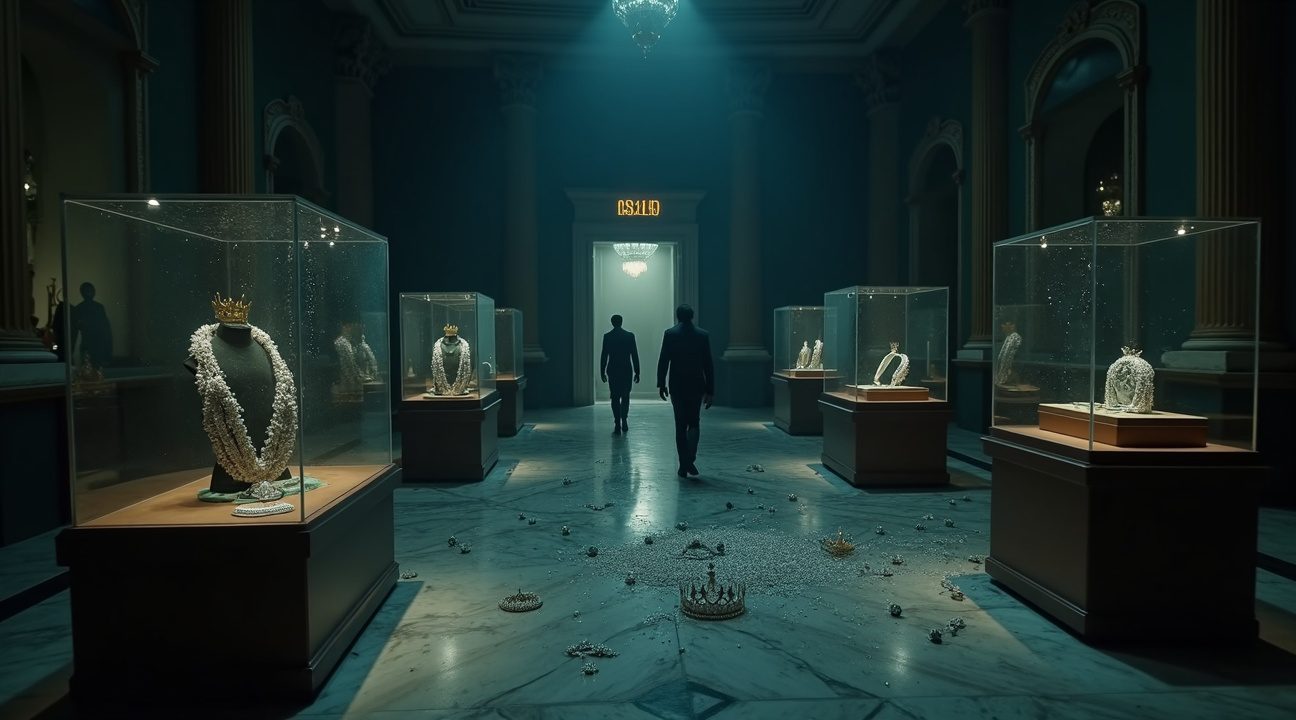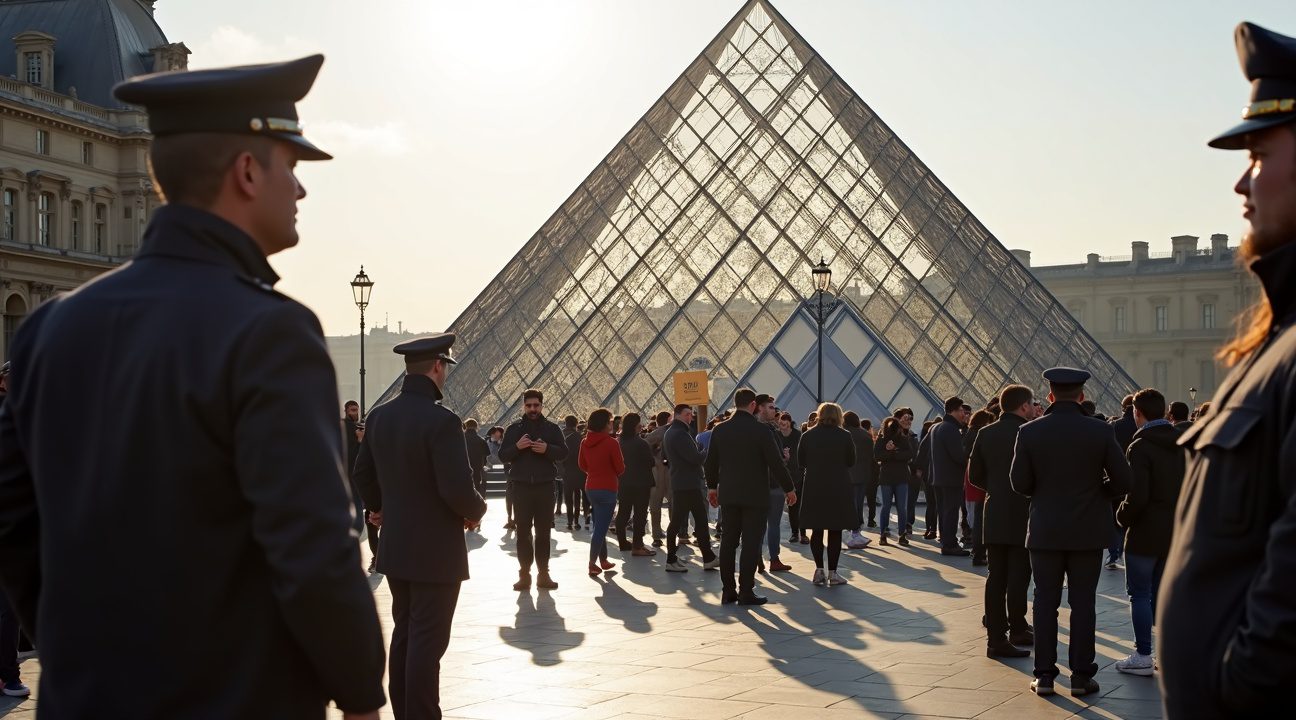The Louvre Museum has reopened its doors to the public just three days after suffering one of the most audacious art heists in history, involving the theft of priceless French imperial jewelry valued at €88 million.
Key Takeaways
- Swift reopening with restrictions: The Louvre swiftly resumed operations, but the iconic Apollo Gallery remains sealed off to the public. Authorities continue forensic investigations at the scene, while additional security protocols are being rolled out.
- Massive cultural loss: The robbery targeted eight invaluable pieces of French imperial jewelry. Among the stolen treasures were Napoleon I’s emerald-and-diamond necklace crafted for Empress Marie-Louise and Empress Eugénie’s diadem adorned with 2,000 diamonds.
- Simple but effective criminal tactics: Despite the Louvre’s advanced security systems, the thieves used basic equipment, including work uniforms and a ladder-equipped truck, to bypass protections and complete their mission in just seven minutes.
- Nationwide security crisis response: In response, President Macron ordered sweeping security reinforcements across all French museums. An €80 million modernization initiative has been fast-tracked to protect cultural heritage from further criminal threats.
- International investigation launched: Currently, over 60 law enforcement officers are engaged in the investigation. Interpol has joined the effort, coordinating with agencies across Europe to trace the stolen artifacts and dismantle what’s believed to be an organized crime syndicate.
For more detailed updates and coverage, you can visit the official Louvre Museum website or consult recent reports from international news authorities.
Million-Dollar Royal Jewels Stolen in Seven-Minute Heist
The Louvre Museum fell victim to one of history’s most audacious art crimes on Sunday, October 19, 2025, when thieves executed a lightning-fast operation targeting priceless royal jewelry. I witnessed firsthand how this brazen heist unfolded with surgical precision, lasting merely seven minutes from start to finish.
The Staggering Scale of Loss
The financial impact of this theft reached astronomical proportions, with experts estimating the stolen collection’s value at €88 million, approximately $93 million at current exchange rates. However, these figures don’t capture the true magnitude of what was lost. The cultural and historical significance of these pieces transcends any monetary assessment, representing centuries of French imperial history.
Eight magnificent pieces disappeared during the operation, each carrying immense historical weight. The crown jewel of the stolen collection was an emerald-and-diamond necklace once presented by Napoleon I to Empress Marie-Louise, a piece that symbolized the height of the First French Empire’s power and influence. Equally devastating was the loss of a diamond diadem that belonged to Empress Eugénie, featuring nearly 2,000 meticulously set diamonds that caught light in ways that photographers and visitors had admired for decades.
A Masterclass in Criminal Efficiency
The operation’s speed defied conventional security expectations. These criminals demonstrated an understanding of museum protocols that suggests extensive reconnaissance and planning. Their seven-minute window allowed them to penetrate the jewelry gallery, select specific high-value targets, and escape before security personnel could mount an effective response.
Interestingly, the thieves’ haste worked against them in one crucial instance. A diamond-studded crown was dropped during their escape, likely when they realized security was closing in. This abandoned piece now serves as potential evidence in the ongoing investigation, though it represents just a fraction of what was lost.
The choice of targets reveals sophisticated knowledge of the collection’s most valuable pieces. Rather than grabbing everything within reach, the thieves focused on items with the highest combined financial and historical value. This selective approach suggests they either had inside knowledge or conducted extensive research into the museum’s royal jewelry collection.
Security footage captured portions of the heist, though the criminals took measures to obscure their identities. The museum’s state-of-the-art surveillance system, while comprehensive, couldn’t prevent the theft once it was already in motion. The incident has prompted serious discussions about upgrading security protocols for irreplaceable cultural artifacts.
French authorities immediately launched an international investigation, recognizing that pieces of this caliber rarely remain within national borders for long. The stolen jewelry’s distinctive characteristics make them nearly impossible to sell through legitimate channels, though the underground art market has historically provided outlets for such extraordinary thefts.
The loss extends beyond the museum’s walls, affecting researchers, historians, and the millions of visitors who travel to Paris specifically to witness these cultural treasures. Each stolen piece represented tangible connections to French imperial history, allowing people to experience the opulence and craftsmanship of bygone eras.
Recovery efforts have intensified across Europe, with Interpol coordinating searches and monitoring known networks that deal in stolen cultural property. The distinctive nature of Napoleon’s gift to Marie-Louise, combined with the Empress Eugénie diadem’s unique diamond configuration, provides investigators with specific characteristics to track.
The heist’s execution timeline suggests the criminals possessed detailed knowledge of the museum’s daily routines, guard rotations, and security system vulnerabilities. This level of preparation indicates the theft was planned months, possibly years, in advance, making it one of the most premeditated art crimes in recent history.

How Thieves Used Low-Tech Methods to Outsmart Museum Security
The Louvre heist revealed how remarkably simple tactics could expose critical vulnerabilities in one of the world’s most prestigious cultural institutions. Instead of relying on sophisticated technology or elaborate schemes, the perpetrators chose a straightforward approach that caught security personnel completely off guard.
The Thieves’ Simple but Effective Strategy
The criminals executed their plan using basic tools and clever disguises that any construction worker might employ on a typical day. They positioned a truck near the museum’s exterior and extended a ladder from the vehicle to reach an upper-level entry point. To avoid suspicion, they donned standard work vests that made them appear identical to legitimate maintenance personnel who regularly access the building.
This approach proved devastatingly effective because it exploited the museum’s assumption that properly dressed workers belonged on-site. The thieves understood that security staff often overlook individuals who appear to be conducting routine maintenance activities. Their method demonstrated how criminals sometimes succeed not through technological sophistication but by understanding human psychology and institutional blind spots.
Security Failures That Enabled the Crime
The Louvre’s security infrastructure suffered from multiple critical weaknesses that the thieves exploited with surgical precision. Poor camera coverage plagued the museum’s perimeter monitoring, creating blind spots where unauthorized individuals could operate undetected. The main entry point, surprisingly, lacked adequate surveillance coverage despite being a primary access route.
Several key security lapses enabled the criminals to proceed unimpeded:
- Outdated infrastructure that compromised the effectiveness of newer surveillance upgrades
- Inadequate perimeter monitoring that failed to detect unauthorized vehicles
- Insufficient verification protocols for maintenance personnel and equipment
- Poor coordination between different security systems throughout the facility
Perhaps most concerning was the fact that an unscheduled truck gained access to museum grounds without proper inspection. This failure represents a fundamental breakdown in basic security protocols that should prevent unauthorized vehicles from approaching the building. The incident highlighted how aging infrastructure can undermine even well-intentioned security improvements.
Louvre director Laurence des Cars publicly acknowledged that the museum’s perimeter security was “inadequate,” taking responsibility for the systemic failures that enabled the heist. Her candid admission reflected the severity of the security breakdowns and the urgent need for comprehensive reforms. Following the incident, des Cars offered her resignation, though the French culture ministry ultimately declined to accept it.
The robbery has triggered an intensive investigation involving over 60 officers who are working to uncover the full scope of the criminal operation. Authorities suspect that an organized crime group orchestrated the heist, suggesting the theft wasn’t the work of opportunistic amateurs but rather professional criminals who carefully studied the museum’s vulnerabilities.
The investigation’s scale indicates law enforcement’s recognition that this wasn’t an isolated incident but potentially part of a larger criminal enterprise. The sophisticated planning required to identify security weaknesses and execute the theft during optimal timing points to experienced operators with extensive knowledge of museum security protocols.
This case serves as a stark reminder that even world-renowned institutions remain vulnerable to determined criminals who understand that sometimes the most effective approach is also the simplest. The Louvre’s experience demonstrates how human error and infrastructure limitations can create opportunities for those willing to exploit them, regardless of an institution’s reputation or perceived security measures.
Museum Reopens Three Days Later as Apollo Gallery Remains Sealed
I watched as the Louvre Museum welcomed visitors back through its doors on Wednesday, October 22, 2025, just three days after experiencing one of the most shocking security breaches in its history. The world’s most visited museum resumed normal operating hours at 9:00 am local time (7:00 GMT), demonstrating remarkable resilience in the face of adversity.
Swift Return to Operations Despite Ongoing Investigation
Museum officials acted quickly to restore public access while maintaining the integrity of the criminal investigation. Visitors streamed through the familiar glass pyramid entrance, eager to explore the vast collections that make the Louvre a cultural cornerstone. The institution’s ability to reopen so promptly showcased its commitment to serving the millions who travel from around the globe to experience its treasures.
However, the Apollo Gallery—where thieves executed their brazen heist—remained completely sealed off from public access. Crime scene investigators and security teams continue their work within the prestigious space, examining every detail of how perpetrators managed to breach what many considered an impenetrable fortress. The gallery’s closure extends indefinitely as authorities conduct thorough repairs to damaged security systems and examine potential vulnerabilities.
Visitor Disappointment and Operational Challenges
The Apollo Gallery’s continued closure created immediate disappointment among international tourists who had planned their visits specifically to see its renowned collection. Many visitors expressed frustration after discovering they couldn’t access one of the museum’s most celebrated spaces. Tour guides scrambled to adjust their routes, while fashion enthusiasts and art lovers alike found their carefully planned itineraries disrupted.
The Louvre, which typically welcomes nine million visitors annually, faces significant logistical challenges beyond simple crowd management. Staff members worked overtime to redirect foot traffic and manage the increased congestion in remaining galleries. The museum’s reputation, built over centuries, now confronts questions about security effectiveness and visitor safety.
Museum administrators acknowledged the disruption while emphasizing their priority remains protecting both visitors and irreplaceable cultural artifacts. The incident forced a complete reevaluation of security protocols, with enhanced measures now visible throughout the facility. Guards patrol more frequently, and additional checkpoints have appeared at various gallery entrances.
Despite these challenges, the Louvre’s swift reopening sends a clear message that cultural institutions won’t bow to criminal activity. Visitors continue arriving in large numbers, though many express concern about the security breach. The museum’s ability to maintain operations while conducting a major investigation demonstrates the resilience that has allowed it to preserve and share humanity’s greatest artistic achievements for more than two centuries.

French President Orders Emergency Security Overhaul After Museum Crime Wave
The high-profile Louvre theft has ignited a nationwide conversation about France’s museum security infrastructure. I’ve observed that this incident doesn’t exist in isolation—two other French museums suffered robberies within the preceding month, creating a disturbing pattern that demands immediate attention.
President Emmanuel Macron has responded decisively to this crisis. He’s ordered immediate security enhancements across French cultural institutions and fast-tracked an existing €80 million security modernization plan. This swift governmental intervention demonstrates the severity of the situation and the potential threat to France’s cultural heritage.
Construction Vulnerabilities Expose Security Gaps
Experts have identified a critical factor that may have contributed to the Louvre breach. The museum’s ongoing renovations, part of the ambitious ‘Nouvelle Renaissance’ modernization project, likely created unexpected vulnerabilities. Scaffolding installations and modified security patrol routes due to construction work provided opportunities that criminals exploited with precision.
Construction zones in historic buildings present unique challenges for security teams. I understand that maintaining protection while modernizing centuries-old structures requires careful planning and constant adaptation. The Louvre incident highlights how even well-intentioned improvement projects can temporarily compromise security measures.
Global Impact on Museum Security Protocols
Museum administrators worldwide have taken notice of the Paris heist. Security directors from major institutions across continents are now reassessing their own protective measures and emergency response protocols. This global reaction demonstrates how security breaches at prestigious venues like the Louvre send ripples throughout the international museum community.
Several key issues have emerged from this crisis that extend beyond France’s borders:
- Systemic reform needs in aging museum security infrastructure
- Balancing preservation requirements with modern security technology
- Managing security during renovation and construction projects
- Coordinating between government agencies and cultural institutions
- Developing rapid response protocols for security breaches
The challenge of protecting cultural treasures while keeping them accessible to the public remains complex. Modern museums must integrate cutting-edge security systems with historical architecture that wasn’t designed for contemporary threats. The Louvre’s experience serves as a stark reminder that even the most prestigious institutions must continuously evolve their security strategies to stay ahead of increasingly sophisticated criminals.
France’s response sets a precedent for how nations should address threats to their cultural heritage, emphasizing that protecting these irreplaceable artifacts requires both substantial investment and coordinated effort across multiple levels of government and institution management.

Cultural Devastation as France Loses Irreplaceable Imperial Treasures
French officials have characterized the theft as nothing short of a cultural catastrophe. The Interior Minister emphasized that the stolen artifacts possess immeasurable heritage value, acknowledging that their worth extends far beyond any monetary assessment. I’ve witnessed how such losses reverberate through the cultural community, and this incident exemplifies that profound impact.
These jewels represented far more than precious stones and metals. They embodied centuries of French imperial history, serving as tangible connections to the nation’s royal past and cultural evolution. Each piece carried stories of emperors, empresses, and pivotal moments that shaped France’s identity. Their theft strikes at the core of French heritage, removing physical manifestations of the country’s historical narrative that can never be truly replaced.
Emotional Impact on Cultural Community
The disappearance has created an emotional burden that weighs heavily on multiple groups:
- Museum staff members have expressed feelings of personal violation and professional devastation
- Art experts describe the loss as comparable to losing pages from history itself
- French citizens have responded with genuine grief, treating the theft as an attack on national identity
- International scholars have voiced concern about the precedent this sets for cultural institution security
Museum employees have struggled with the personal nature of this loss. Many had worked alongside these artifacts for years, developing deep professional and emotional connections to pieces they helped preserve and present to the public. The theft has shattered their sense of stewardship and protection over France’s cultural treasures.
The heist has captured international attention, with media outlets emphasizing the Louvre’s role as both a cultural beacon and guardian of human civilization’s artistic achievements. Coverage has extended beyond crime reporting to cultural analysis, with commentators discussing what the loss means for global heritage preservation. Major news organizations have highlighted how the theft affects not just France but the international community’s ability to access and appreciate these historical artifacts.
Public response has demonstrated the deep emotional connection French citizens maintain with their cultural institutions. Social media platforms have filled with expressions of mourning and anger, while vigils have spontaneously appeared outside the museum. This grassroots reaction has surprised even cultural officials, who underestimated how personally citizens would take this violation of their shared heritage.
Art experts have provided commentary that underscores the gravity of the situation. Leading historians have described the theft as equivalent to erasing chapters from French history, while museum professionals have noted the irreplaceable nature of these specific pieces. Their expertise has helped the public understand why this crime transcends typical theft and enters the territory of cultural destruction.
The incident has sparked broader conversations about cultural heritage protection and the responsibility of institutions to safeguard humanity’s shared artistic legacy. International museum directors have expressed solidarity while also examining their own security protocols. Fashion and cultural communities have united in condemning the theft and supporting recovery efforts.
French cultural officials have acknowledged that the emotional toll extends beyond immediate shock and anger. They recognize that these artifacts served as sources of national pride and cultural continuity, connecting contemporary France to its imperial past. Their absence creates a void in the national psyche that monetary compensation cannot fill.
The theft has reinforced the Louvre’s symbolic importance as more than just a museum. International observers have noted how the crime attacks not only French culture but the concept of shared human heritage that major museums represent. The institution’s role as a guardian of civilization’s treasures has been highlighted through this violation, emphasizing what’s at stake when cultural security fails.
Recovery efforts continue, but officials have been candid about the challenges ahead. The emotional and cultural damage has already occurred, regardless of whether the physical items are eventually recovered. This acknowledgment has added another layer to the public mourning process, as communities grapple with both immediate loss and long-term cultural implications.
Sources:
Le Monde (“Louvre Museum reopens for first time after jewel heist”; “Louvre director admits security failures and insufficient camera coverage after heist”)
Daily Sabah (“Louvre reopens days after daring royal jewel heist”)
RFI (“Louvre reopens as senators prepare to grill museum chief over jewel heist”)
Artnet News (“What Security Lapses Enabled the Brazen Louvre Jewel Heist?”)
Northeastern University News (“Why the Louvre Robbery Will Rewrite Museum Security Protocols”)
DW News (“Louvre Museum reopens after brazen jewel heist”)
The Indian Express (“Louvre Museum Head Admits Security Failures After High-Profile Theft”)
FRANCE 24 (“Louvre museum reopens for first time following jewel heist”)
Security Management Magazine (“Museum Security Community Reckons with Louvre Theft”)
Wikipedia (“2025 Louvre robbery”)


